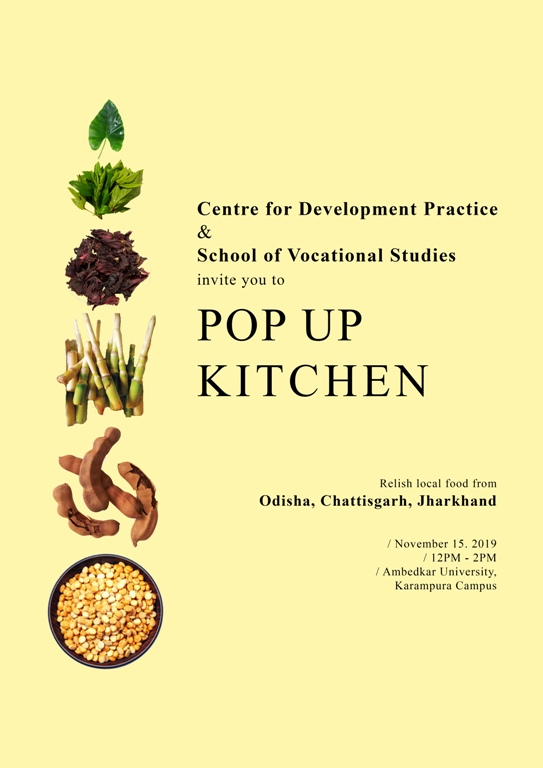- Event Date :-15-November-2019
- Event Time :-12:00 pm to 02:00 pm
- Venue :-Near Canteen, Karampura campus
Dear All,
Centre for Development Practice (www.cdp.res.in) in collaboration with the School of Vocational Studiesis setting up a pop up kitchen to put to display food from Jharkhand, Odisha and Chattisgarh. The food on display has been cooked from food grains and vegetables grown in these three states with indigenous seeds and indigenous know-how; fertilizers, pesticides or herbicides have not been used. This is largely an initiative of the CDP Fellows in Action Researchand Research Associates and the students of BVoc Tourism and Hospitality. The effort is born out of a response to the process of the gradual loss of difference in food cultures. The attempt, in this pop up kitchen, is to one, bring the consumer and producer closer by informing the former about the latter and the processes the latter deploys; two, to carry the diverse menu of rural local food to the urban globalised dining culture. This pop up kitchen also aims to bring recipes from the (rural) producer’s world to University so as to represent, in however limited a form, the hidden diversity of food cultures in our country such that it not only reduces the producer-consumer gap but also pays attention towards how our food habits are increasingly becoming inclined towards the “polished” (‘white rice’ for example) than what is “nutritional”. However, the whole effort is not limited to the pursuit of knowing about local food cultures but about the experience of cooking such food and getting a taste of the diverse food cultures of rural central India. We invite you to visit our pop up kitchen unit between 12 noon and 2 pm (SVS Restaurant, Karampura Campus); a rather diverse menu from Jharkhand, Odisha and Chattisgarh shall be on display for all of us as perhaps a welcome break.
MENU
Drinks
Rice Tea: This may be called tea without tea leaves. In the absence of tea leaves the indigenous communitiesin Jharkhand have discovered an innovative way to welcome their guests using local ingredients. They thus, prepare rice tea, where rice is dry-roasted until it changes colour. The roasted rice is then boiled in water. This tea can be had with or without sugar. Tenturi Charu: All round the year indigenous food plates include a tangysoupy dish prepared with seasonal ingredients. TenturiCharu is one of these tangysoupy dishes. Tenturi is tamarind or imli in Oriya. Tamarind trees are commonly available in Central India, and tamarind can be stored for a long time. This charu is prepared with tamarind water and salt and finally given a tadka with local spices. The delicacy is most relished with steamed rice.
Starters
Peetha: This is a recipe fromthe kitchens of Munda and Oraon(indigenouscommunities) households. It is largely cooked on festive occasions. This dish is cooked by using rice flour and urad dal (pulse). Urad is soaked overnight and grinded the next day. This mixture is stuffed in a rice flour covering and steamed or boiled. Finally the dumpling like small pieces of peetha is given a tadka.
Dal Vada: Vada is a common dish in the South Indian food plate. However, this vada marks its flavorful differences strongly. The soaked and grinded urad lentils are fried and served with spicychutney. These lentils are organically grown in the fields of South Orissa, and carry an important place in the rural food culture. This is an age old recipe cooked during festivals.
Main course
Tamatar chutney: A staple in Chhatsgarhi households in winters, tomatoes are cooked with garlic, chillies and coriander. The flavour of this Tamatar chutney is accentuated by pairing it with karil (dry bamboo shoot).
Dal Khatta: An all year long delicacy in Chhattisgarhi households where Arhat Dal is boiled and spiced up with Roselle leaves or flowers (khattabhaji), garlic and chillies. Khattabhaji gives a tangy touch to the Dal.
Kumhdaaur Kanda kisabzi: This recipe is an important festive dish. Every year it is cooked on the day after Devari (or Diwali) when each household in the village gifts and exchanges different varieties of tubers. These tubers are mixed with pumpkin and cooked in the puree of unripe tamarind.
AlooBiganTarkari: This recipe is common to Kondha kitchens and is simple to prepare. The unique aspect of this recipe is that no oil is used in its cooking. Potato and brinjal are boiled in water and spices are added to it. It is flavoured with roasted and powdered panchforan and for some tanginess, tamarind or tomato.
Sweets
Arsa: Known by different names in different regions, arsa or anarsa is a part of festivities. Arsa is a dessert cooked with rice flour and jaggery. It is generally cooked in larger quantities in the villages of Central India such that it can be distributed amongst relatives or stored in the households for consumption in future.
Pop-up Kitchen picture gallery



 डॉ. बी. आर. अम्बेडकर विश्वविद्यालय दिल्ली
डॉ. बी. आर. अम्बेडकर विश्वविद्यालय दिल्ली 


